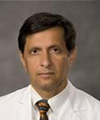Hepatology
Liver Fibrosis
Personalized Medicine for Nonalcoholic Fatty Liver Disease
Overview
Fulfilling the goal of personalized medicine in nonalcoholic fatty liver disease (NAFLD) would improve the clinician’s ability to risk stratify patients and to tailor their approach to prevention, diagnosis, and treatment. Such an approach would likely comprise a genetic risk assessment in concert with a consideration of established risk factors, such as obesity, diabetes, and metabolic syndrome.
How do you envision the development of personalized medicine in NAFLD?
Ashwani K. Singal, MD, MS, AGAF, FACG, FAASLD
|
|
“Personalized medicine for NAFLD is an important clinical unmet need. As hepatologists, we all struggle with determining which patients with NAFLD will progress over the years to advanced disease.”
Personalized medicine for NAFLD is an important clinical unmet need. As hepatologists, we all struggle with determining which patients with NAFLD will progress over the years to advanced disease. If you consider the natural history of NAFLD, only a small subset will actually progress; however, it is a slow progression that may take decades. And currently, when I see an individual with NAFLD in the clinic, I cannot tell them with certainty what their chances are of progressing to cirrhosis or advanced fibrosis in the next 20 years.
The development of an accurate tool, a predictive model, or an approach using machine learning or artificial intelligence would help us in our discussions with patients. This would enable us to tell our patients something like, “Your risk of developing a bad liver-related disease 20 years from now is high, so you should be more proactive in reducing your risk with lifestyle interventions.” If lifestyle interventions are implemented and do not work for a patient, then we could have a lower threshold for recommending bariatric surgery based on that individual’s high risk of developing cirrhosis in the future. So, that is an example of how the personalized medicine approach would be helpful. Another benefit is related to the identification of fast progressors. Approximately 7% to 10% of patients with NAFLD are fast progressors, but we do not yet know how to identify which of our patients with NAFLD will have rapid progression.
Several genetic markers, such as PNPLA3, TM6SF2, or MBOAT7, have been robust predictors of the development of or the protection against advanced liver fibrosis, and they would be helpful variables to include in a model. Other variables to consider including are gender, ethnicity, microbiome changes, and family history. Having these factors compiled in a model- or artificial intelligence–based approach to help risk stratify patients and execute personalized treatment in our patients would be very useful for clinicians.
Raymond T. Chung, MD
|
|
“A patient’s genetic risk score, together with assessments of the current state of their liver disease, could really provide a glimpse into an individual’s status and their outlook in terms of where their disease may be headed. It is quite likely that genetic markers could also highlight pathway-specific approaches that may be more successful in a given individual.”
Tailoring our approach to the individual with NAFLD is critical, whether we are talking about lifestyle changes, weight reduction, or diabetes control. However, there is also an underlying substrate, or one’s own genetic makeup, to consider. Genetic polymorphisms at several distinct loci have been described as being strongly associated with the presence and/or severity of NAFLD. The most well-investigated genes include PNPLA3, TM6SF2, and MBOAT7, as previously mentioned, but many others are just now being described, including higher-frequency alleles with potentially small or modest effect sizes and rare alleles that may have even larger effect sizes. The idea is that these could be pooled into a genetic risk index. A patient’s genetic risk score, together with assessments of the current state of their liver disease, could really provide a glimpse into an individual’s status and their outlook in terms of where their disease may be headed. It is quite likely that genetic markers could also highlight pathway-specific approaches that may be more successful in a given individual.
Some of the genetic polymorphisms do not always indicate specific proteins that we can interdict or block, but I think that we are increasingly moving toward the use of indices, secreted markers, or even transcriptomic markers that may reveal something about those specific genes and proteins that are upregulated or downregulated in each condition. This will give us clues about the pathways or networks that are particularly deranged in a specific patient and could allow us to develop modifiers of those pathways to apply in that individual.
There is much to look forward to in the application of these strategies. There are likely many different subtypes of the NAFLD disorder, and these tools will lend us more precision in matching treatments to patients in clinical trials.
Arun J. Sanyal, MD
|
|
“All of these genetic pathways are giving us tremendous insight, and, at some point in the future, using genetic material either from circulating blood or from liver biopsies will enable us to determine which pathways are activated and to what degree in an individual patient.”
We are clearly learning a lot about the genetic drivers for the polygenic risk course for NAFLD, which not only would be part of a risk stratification strategy but also would help tailor therapeutics. When we follow the disease and its progression in animals, the transcriptome, which can be defined as the gene expression profile within the liver, changes as the disease develops and progresses over time. We have data from animal models that have been followed longitudinally and from human samples, the latter of which have enabled us to see a growing contribution of specific types of inflammatory cells, particularly TREM-2–positive macrophages, in the progression of the disease.
There are other pathways, such as the Hedgehog and the Hippo-YAP signaling pathways, that have been linked to disease progression, and we are now learning about changes in the regenerative response. Progression can be a function of increasing injury and scarring of the liver, as well as an exhaustion of the liver’s ability to regenerate and restitute function.
All of these genetic pathways are giving us tremendous insight, and, at some point in the future, using genetic material either from circulating blood or from liver biopsies will enable us to determine which pathways are activated and to what degree in an individual patient. One pathway may be a driver of the disease at one point, but as the disease progresses toward cirrhosis, there may be other drivers at another point. Clinicians need to know what is relevant at any given time point for a particular patient since disease driver information impacts therapeutic approaches.
References
Balakrishnan M, Patel P, Dunn-Valadez S, et al. Women have a lower risk of nonalcoholic fatty liver disease but a higher risk of progression vs men: a systematic review and meta-analysis. Clin Gastroenterol Hepatol. 2021;19(1):61-71.e15. doi:10.1016/j.cgh.2020.04.067
Driskill JH, Pan D. The hippo pathway in liver homeostasis and pathophysiology. Annu Rev Pathol. 2021;16:299-322. doi:10.1146/annurev-pathol-030420-105050
Gough A, Soto-Gutierrez A, Vernetti L, Ebrahimkhani MR, Stern AM, Taylor DL. Human biomimetic liver microphysiology systems in drug development and precision medicine. Nat Rev Gastroenterol Hepatol. 2021;18(4):252-268. doi:10.1038/s41575-020-00386-1
Lonardo A, Arab JP, Arrese M. Perspectives on precision medicine approaches to NAFLD diagnosis and management. Adv Ther. 2021;38(5):2130-2158. doi:10.1007/s12325-021-01690-1
Longo M, Meroni M, Paolini E, et al. TM6SF2/PNPLA3/MBOAT7 loss-of-function genetic variants impact on NAFLD development and progression both in patients and in in vitro models. Cell Mol Gastroenterol Hepatol. 2021;13(3):759-788. doi:10.1016/j.jcmgh.2021.11.007
Lu L, Finegold MJ, Johnson RL. Hippo pathway coactivators Yap and Taz are required to coordinate mammalian liver regeneration. Exp Mol Med. 2018;50(1):e423. doi:10.1038/emm.2017.205
Meroni M, Longo M, Tria G, Dongiovanni P. Genetics is of the essence to face NAFLD. Biomedicines. 2021;9(10):1359. doi:10.3390/biomedicines9101359
Romeo S, Sanyal A, Valenti L. Leveraging human genetics to identify potential new treatments for fatty liver disease. Cell Metab. 2020;31(1):35-45. doi:10.1016/j.cmet.2019.12.002
Zhu B, Chan S-L, Li J, et al. Non-alcoholic steatohepatitis pathogenesis, diagnosis, and treatment. Front Cardiovasc Med. 2021;8:742382. doi:10.3389/fcvm.2021.742382













